The Place of Energy Security in the National Security Framework: An Assessment Approach
Abstract
1. Introduction
2. Literature Review
- Excessive dependence on energy imports;
- Insufficient level of diversification of energy supply sources and technologies;
- Limited use of own energy potential and new technologies;
- Low fuel and energy efficiency;
- Distortion of market mechanisms in the energy sector;
- Criminalization and corruption of the energy sector;
- Ineffective energy efficiency and energy supply policy.
3. Methodology
4. Results
- Electric power consumption (kWh per capita);
- Fuel imports (% of merchandise imports);
- Adjusted savings: energy depletion (% of GNI);
- Electric power transmission and distribution losses (% of output);
- Alternative and nuclear energy (% of total energy use);
- Electricity production from renewable sources, excluding hydroelectric (% of total);
- Adjusted net savings, including particulate emission damage (% of GNI);
- Adjusted savings: carbon dioxide damage (% of GNI);
- Access to electricity (% of the population);
- Access to electricity, rural (% of rural population);
- Access to electricity, urban (% of urban population).
5. Discussion and Conclusions
Author Contributions
Funding
Institutional Review Board Statement
Informed Consent Statement
Data Availability Statement
Conflicts of Interest
Appendix A
| Region | Geo-Economic Situation | Energy Security Paradigm in the Region |
|---|---|---|
| North America | The United States continues to play its role as a superpower. Due to rising energy prices, the country is using a variety of new ideas. Cars with hybrid engines or alternative engines are used. Mexico manages to curb the rise of violence against criminal groups. Canada has hardly changed. It has improved its economy through its energy assets [19]. | In general, the state of energy security in the United States has radically changed over the past decade. In many ways, the country has a strong position to create a reliable, affordable, and environmentally sustainable energy system. In particular, the United States is constantly improving and modernizing energy production: the oil and gas industry through horizontal drilling and hydraulic technology. Harmful emissions from coal mining have declined over the past decade as the United States developed natural gas-fired generators (which are more competitive in the market) during the shale gas boom. Meanwhile, renewable energy sources are also rapidly growing, thanks to lower costs and political support. One part of U.S. energy security is the development of terminals in other countries for LPG exports. Mexico’s population is expected to grow to nearly 150 million by 2050 from 127 million today. Along with increased productivity, this will stimulate economic growth. As a result, energy demand will increase significantly. The energy balance of this country is dominated by oil and gas, with oil accounting for almost half of the total. Mexico has a fast-growing electricity sector and demand has been growing at an average of 1.6% per year since 2000. Natural gas is a major source of electricity, much of which is imported from the United States and benefits from low gas prices in North America. |
| Central and South America | Continued anti-Americanism, led by Venezuelan leader Hugo Chavez, has led the state to break away from U.S. influence. Brazil remains the main geopolitical player in the region, which is going through difficult times of restructuring its economy. Venezuela has significant problems, where the economic model does not promote friendly contacts with either its neighbors or the United States. In other countries, a significant demographic growth is observed, which is not supported by economic growth, which complicates social problems within states. Countries are very vulnerable to external shocks [22]. | Brazil’s energy policy responds well to the world’s most pressing energy challenges. Access to electricity across the country is almost unlimited, and renewable energy sources meet almost 45% of primary energy demand, making Brazil’s energy sector one of the lowest in the world [20]. Fossil fuels are unevenly distributed in Latin America. Oil and gas reserves are concentrated in Venezuela, while most coal reserves are in Colombia and Brazil. In 2020, hydropower dominated Central and South American electricity generation, which accounted for approximately 67 percent of America’s total gross domestic production [21]. |
| The EU | The EU is trying to gradually expand at the expense of the Balkan countries, but due to the presence of internal contradictions cannot do it quickly. Significant inhibitions of economic activity in recent years and the inefficiency of part of the economy of education are forcing economic reforms to be carried out, which are not to the liking of member states, which only complicates the situation. Population aging, an influx of migrants, and high unemployment, which do not contribute to solving social problems. In terms of improving living standards, the EU is actively implementing new environmental standards that affect producers’ ability to use scarce resources. At the same time, the EU is interested in diversifying the supply of resources, which does not allow it to take a tougher stance in negotiations with Russia on future enlargement [23]. | Germany created a strategy for energy policy until 2050, which provides for an accelerated withdrawal from nuclear energy by 2022. France has a very low carbon balance due to well-established policies and the modernization in this sector. France plans to reduce the share of nuclear power plants from 70% to 50% in its electricity structure by 2035, and close its last coal-fired power plants by 2022. Many nuclear reactors are out of service, requiring the modernization of those that can operate in the long run. According to the draft energy policy of Poland until 2040, the share of coal and lignite in electricity production will be reduced to slightly less, by 60%, by 2030. The draft policy also prioritizes long-term energy security, reducing greenhouse gas emissions and air pollution, improving energy efficiency, and decarbonizing the transport system. In the Czech Republic, the main goals are to reduce energy consumption, increase the energy intensity of the economy, and expand nuclear energy by about 2500 MW by 2035. Fossil fuels are still a key element of the energy sector in the Czech Republic. Air pollution is a particular problem due to the widespread use of coal and the relatively old car fleet, which is dominated by diesel cars. However, per capita, CO2 emissions and the carbon intensity of the economy are among the highest in Europe. Italy’s energy policy is focused on renewable energy sources. The country had impressive success in the renewable energy sector and succeeded in integrating large volumes of renewable generation. In addition, institutional arrangements in the energy sector remain complex and need to be reformed and strengthened. Greece has set targets to reduce greenhouse gas emissions by more than 56% by 2030, compared to 2005, and to have a climate-neutral economy by 2050. In general, some countries can generate at least 80% of all electricity from recycling, wind and solar power plants, and biofuels, when introducing alternative energy sources. EU countries plan to ban internal combustion engines in the next 15 years, which will significantly change the structure of energy consumption. The government is implementing reforms to standardize and simplify the licensing procedures for renewable energy projects and is exploring options for using offshore wind energy. The Greek islands also have renewable energy projects to decarbonize electricity [23,24]. |
| The Middle East and Middle Asia | Iraq continues to thrive despite attacks by insurgents and terrorists. US troops are leaving the country. Advisers and some combat units remained to assist the Iranians in ensuring security. Iraq supports new European gas and oil pipelines to Turkey. There are tensions with Iran–radical Islamists and democratic groups plunge the country’s major cities into civil war. Not wanting to risk losing refineries, the United States is developing a strategy to find new fields. Recent developments in Libya, along with ongoing territorial disputes between several Eastern Mediterranean countries, especially the disputes between Turkey, Greece, and Cyprus over their respective SEZs, have hampered the exploration and development of the region, especially in the Levant Sea basin. If geopolitics is an argument for the future world order, then the Eastern Mediterranean, like no other, is becoming a cauldron of conflicting views and interests. The geopolitical interests of the Eastern Mediterranean countries will inevitably influence geoeconomic decisions regarding the flow and exchange of traded gas [25]. The Middle East is experiencing a series of geopolitical crises and wars involving the shifting role of oil in the global economy and the attempts to secure or redistribute those incomes. Most of the conflicts are related to oil-bearing countries, namely Libya, Syria, Turkey, Iraq, Iran, Azerbaijan, Saudi Arabia, and Yemen. | In the struggle for energy routes, naval conflicts in the Eastern Mediterranean are intensifying. The risk of confrontation between regional states is growing. The development of the maritime border dispute between Turkey, Greece, and France is accelerating and deepening. The belligerent statements and threats of high-ranking government officials from the three countries, accompanied by numerous military conflicts, still bypass diplomatic relations aimed at overcoming a future clash between two—or possibly three—NATO members. At the heart of the recent crisis between Greece and Turkey is a dangerous ideological model, not just a dispute over energy resources. The oil blockade in Libya has been going on for 9 months, and oil production in the war-torn country fluctuates only at 100,000 barrels per day instead of the pre-crisis 1.2 million barrels per day. The COVID-19 pandemic is just the tip of the iceberg of the socio-political and economic problems of the Eastern Mediterranean. What makes the Eastern Mediterranean so incendiary today is the combination of several complex and volatile issues, including historical ambitions, conflicting claims to sovereignty, competition for control of newly discovered natural gas reserves, pipeline policy, civil wars and political chaos in coastal states, reduction in U.S. states, the expansion of the Russian naval base in Syria, the expansion of Turkey in Libya, the differences between NATO allies, and the waves of migration and refugees. The collective interest in mobilizing the Eastern Mediterranean’s gas reserves has expanded cooperation between Greece, Cyprus, Israel, and Egypt, as well as key energy companies from the United States, Israel, Italy, and France. This group has grown to include Italy, Jordan, and Palestine, culminating in the creation of the Eastern Mediterranean Gas Forum (EMGF). Middle Eastern countries have different understandings of energy security. If the pennies of the state will be energy-neutral economies, where the role of alternative energy sources is constantly growing, then others are trying to maintain their role as major producers of oil and gas. To do this, there is a struggle for new markets, including liquefied natural gas. |
| Scope of the Research | State and Period under Analysis | The Goal of the Research | Mathematical Approach Used | Results Obtained |
|---|---|---|---|---|
| Evaluation of energy security as a component of the national security of the country [2] | 2011–2017, Russia, China, U.S.A., Czech Rep., Poland, Sweden, and Germany | To calculate and select the indicators of energy independence. | The multidimensional mean, the selection of statistical indicators, the choice of the base of their normalization, the use of the analytic hierarchy process for the evaluation of weighting coefficients, the method of aggregation of indicators in the integrated evaluation of energy independence, and analysis of the time series. | The country’s energy independence requires quantitative evaluation to ensure regulatory actions in this area of government activity. To do this, it is necessary to highlight the most significant both absolute and relative indicators, which evaluate the country’s energy independence. |
| Evaluation of sustainable energy security and an empirical analysis of China [27] | China, 2004–2015 | Study of the impact of geopolitics on China’s energy security, achieving sustainable development of the national energy system as a decisive factor in the country’s development. Creation of a theoretical system of energy evaluation | China’s Sustainable Energy Security (CSES) index calculation, its empirical study for 2004–2015. The initial values of each indicator were calculated by the min _max method, and a matrix of solutions was constructed. | The measures that need to be taken by government agencies to support the goals of energy security and energy sustainability are recommended. The priority of the development of clean energy in the strengthening of coefficient of energy self-sufficiency is specified. |
| Estimating the interrelation between energy security and macroeconomic factors in European countries [1] | 1997–2016, 28 EU | Analysis of energy security in some European countries and the assessment of energy security. Defining how the level of energy security is related to the main macroeconomic parameters of countries. | Calculation of the Shannon–Wiener index, its comparison with the share of energy from renewable sources, and NESI representation. Development of a new energy security index NESI, which thoroughly describes the real threats and opportunities of European countries in terms of energy security. Based on energy consumption, production, distribution, and efficiency. | Indication of the shortcomings of the existing energy security indices. Analysis of the ratio of the NESI index with the main macroeconomic indicators in different European countries GDP growth is positively correlated with NESI and negatively with CPI. Therefore, on the one hand, economic instruments can improve energy security in Europe, and, on the other hand, guaranteeing energy security leads to lower prices and increased national production. The study helps to identify the most valuable EU countries for energy security, which will suffer the most in the case of, for example, the destruction of a single gas system. Using NESI can help understand how countries respond to international change if they can sustain the required level of technological change in energy production and distribution. |
| National energy security assessment from a geopolitical perspective [28] | Italy | An overarching methodology is outlined to evaluate energy security, in which its external and internal dimensions are considered and integrated: the security of the energy supply from abroad (external) and the security of national energy infrastructures (internal). | Two indexes are defined using a probabilistic approach. | The evaluation of energy security needs to consider different dimensions and is of the utmost importance as a benchmark to conceive and implement different policies. |
| Introduction to energy sSecurity, national security and citizenship (case study of Iran) [29] | Iran | The present study seeks to address the relationship between energy security, national security, and civil rights, and it considers the various dimensions of energy security that have affected civil rights based on the rights enshrined in the Charter of Civil Rights and other legal documents. | Descriptive statistics. | Energy insecurity is one of the threats to national security, and looking at it from the perspective of civil rights can highlight the commitment of governments to ensure its realization. |
Appendix B. Regression Results

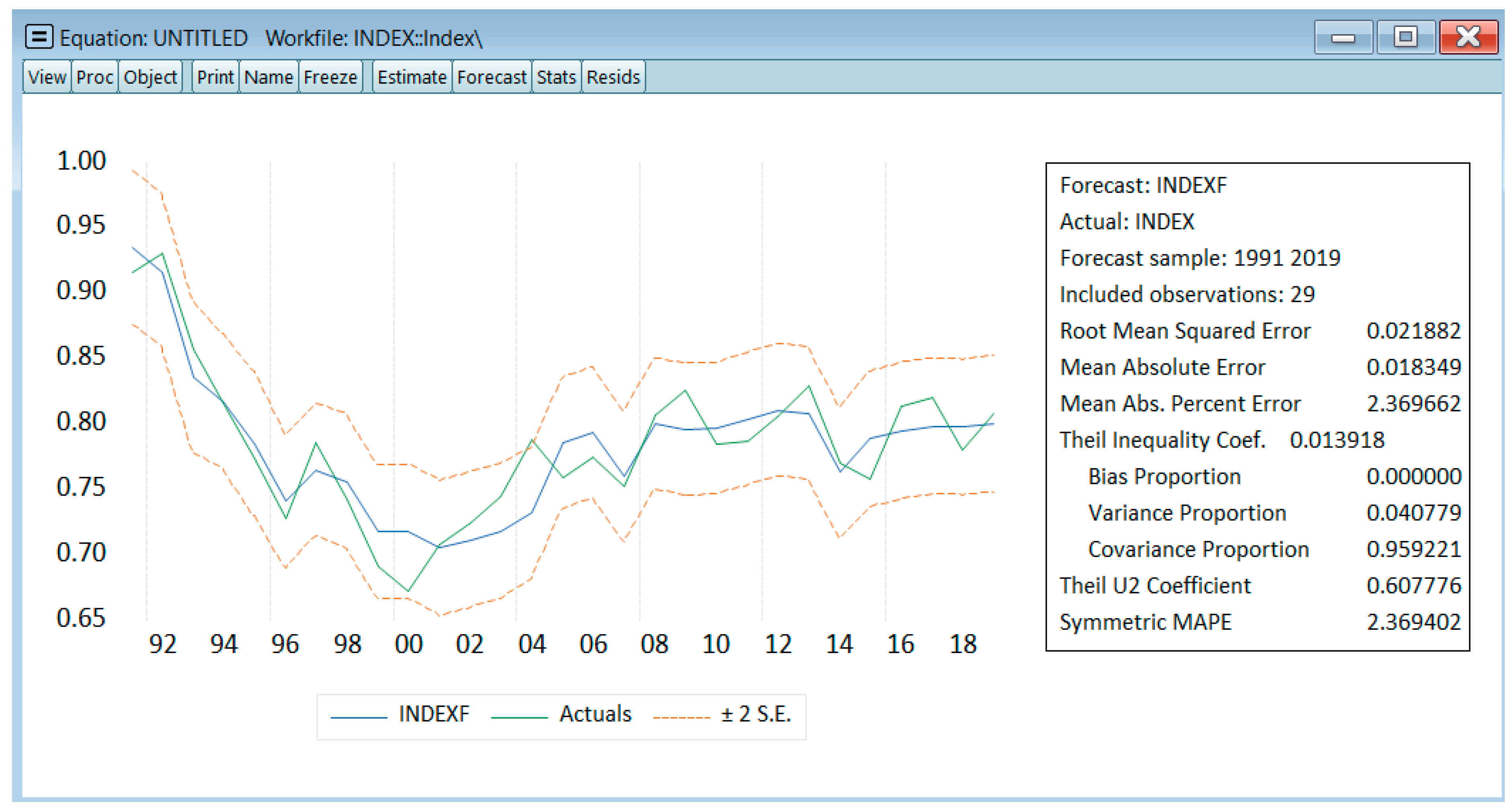
References
- Stavytskyy, A.V.; Kharlamova, G.; Giedraitis, V.; Šumskis, V. Estimating the interrelation between energy security and macroeconomic factors in European countries. J. Int. Stud. 2018, 11, 217–238. [Google Scholar] [CrossRef]
- Dźwigoł, H.; Dźwigoł-Barosz, M.; Zhyvko, Z.; Miśkiewicz, R.; Pushak, H. Evaluation of the energy security as a component of national security of the country. J. Secur. Sustain. Issues 2019, 8, 307–317. [Google Scholar] [CrossRef]
- Song, Y.; Ming, Z.; Ruifeng, S. Using a new aggregated indicator to evaluate China’s energy security. Energy Policy 2019, 132, 167–174. [Google Scholar] [CrossRef]
- Nate, S.; Bilan, Y.; Cherevatskyi, D.; Kharlamova, G.; Lyakh, O.; Wosiak, A. The impact of energy consumption on the three pillars of sustainable development. Energies 2021, 14, 1372. [Google Scholar] [CrossRef]
- Chernyak, O.; Kharlamova, G.; Stavytskyy, A. Trends of international energy security risk index in European countries. TalTech J. Eur. Stud. 2018, 8, 5–32. [Google Scholar] [CrossRef]
- Kharazishvili, Y.; Kwilinski, A.; Sukhodolia, O.; Dzwigol, H.; Bobro, D.; Kotowicz, J. The systemic approach for estimating and strategizing energy security: The case of Ukraine. Energies 2021, 14, 2126. [Google Scholar] [CrossRef]
- Stavytskyy, A. Influence of modern geopolitical challenges on state’s economic security. Bull. Taras Shevchenko Natl. Univ. Kyiv. Econ. 2018, 4, 45–55. [Google Scholar] [CrossRef][Green Version]
- Blazev, A.S. Energy Security for the 21st Century; River Publishers: Aalborg, Denmark, 2021. [Google Scholar]
- Tvaronavičiene, M. Innovation in Energy Security and Long-Term Energy Efficiency. 2020. Available online: https://www.mdpi.com/books/pdfview/book/2752 (accessed on 28 November 2021).
- Wang, B.; Wang, Q.; Wei, Y.M.; Li, Z.P. Role of renewable energy in China’s energy security and climate change mitigation: An index decomposition analysis. Renew. Sustain. Energy Rev. 2018, 90, 187–194. [Google Scholar] [CrossRef]
- Zhang, L.; Yu, J.; Sovacool, B.K.; Ren, J. Measuring energy security performance within China: Toward an inter-provincial prospective. Energy 2017, 125, 825–836. [Google Scholar] [CrossRef]
- National Bureau of Statistics of China. Available online: http://www.stats.gov.cn/english/ (accessed on 10 October 2021).
- Kemp, J.C.; China’s Five-Year Plan Focuses on Energy Security. Reuters. Available online: https://www.reuters.com/article/us-column-china-energy-kemp-idUSKBN2BB1Y1 (accessed on 15 October 2021).
- Our World in Data. States. Available online: https://ourworldindata.org/energy/country/ (accessed on 10 October 2021).
- Li, M.; Li, L.; Strielkowski, W. The impact of urbanization and industrialization on energy security: A case study of China. Energies 2019, 12, 2194. [Google Scholar] [CrossRef]
- Kenderdine, M.; Hochstein, A. Valuation of Energy Security for the United States; Report to Congress; U.S. Department of Energy: Washington, DC, USA, 2017. [Google Scholar]
- Stocking, A.; Kyle, J.; Moore, D. Energy Security in the United States; Congressional Budget Office Report; CBO: Washington, DC, USA, 2012. [Google Scholar]
- The Global Economy. Available online: https://www.theglobaleconomy.com/rankings/external_interventions_index/ (accessed on 10 October 2021).
- Stavytskyy, A. Geopolitical climate of Black Sea region. In Emerging Importance of Wider Black Sea Area Security; Lucian Blaga University of Sibiu: Sibiu, Romania, 2018; pp. 107–117. [Google Scholar]
- STATISTA. Electricity Generation in South and Central America in 2020, by Fuel Type. Available online: https://www.statista.com/statistics/983336/central-south-america-electricity-generation-source/ (accessed on 20 October 2021).
- Balza, L.H.; Espinasa, R.; Serebrisky, T. Lights on? Energy Needs in Latin America and the Caribbean to 2040; Inter-American Development Bank: Washington, DC, USA, 2016; Available online: https://publications.iadb.org/publications/english/document/Latin-America-Energy-Future.pdf (accessed on 20 October 2021).
- Energy Wars Map. Available online: https://www.deviantart.com/paintfan08/art/Energy-Wars-Map-118715749 (accessed on 20 October 2021).
- International Energy Agency. Available online: https://www.iea.org/countries/ (accessed on 25 October 2021).
- Energy Wars and Naval Diplomacy in the Mediterranean. 2020. Available online: https://www.semedenergydefense.com/report-7-energy-wars-and-naval-diplomacy-in-the-mediterranean/ (accessed on 25 October 2021).
- Energy Security in the Epoch of Hybrid Wars. 2021. Available online: https://www.nato.int/docu/review/uk/articles/2021/01/13/energetichna-bezpeka-v-dobu-gbridnih-von/index.html (accessed on 25 October 2021).
- Norouzi, N.; Fani, M. The impacts of the novel corona virus on the oil and electricity demand in Iran and China. J. Energy Manag. Technol. 2020, 4, 36–48. [Google Scholar]
- Walker, M. Russia v. Europe: The energy wars. World Policy J. 2007, 24, 1–8. [Google Scholar] [CrossRef]
- Demetrious, K. ‘Energy wars’: Global PR and public debate in the 21st century. Public Relat. Inq. 2019, 8, 7–22. [Google Scholar] [CrossRef]
- Wolfe, W.M.; Tessman, B.F. China’s global equity oil investments: Economic and geopolitical influences. J. Strateg. Stud. 2012, 35, 175–196. [Google Scholar] [CrossRef]
- Le Billon, P. The geopolitical economy of ‘resource wars’. Geopolitics 2004, 9, 1–28. [Google Scholar] [CrossRef]
- Moran, D.; Russell, J.A. Energy Security and Global Politics: The Militarization of Resource Management; Routledge: Abington-on-Thames, UK, 2008; Volume 6. [Google Scholar]
- Samaras, C.; Nuttall, W.J.; Bazilian, M. Energy and the military: Convergence of security, economic, and environmental decision-making. Energy Strategy Rev. 2019, 26, 100409. [Google Scholar] [CrossRef]
- Alshwawra, A.; Almuhtady, A. Impact of regional conflicts on energy security in Jordan. Int. J. Energy Econ. Policy 2020, 10, 45. [Google Scholar] [CrossRef]
- Bichler, S.; Nitzan, J. Energy conflicts and differential profits: An update. Res. Note 2014, 1–5. Available online: http://pinguet.free.fr/bichler1014.pdf (accessed on 30 November 2021).
- Stergiou, A.; Karagianni, M. Does Energy Cause Ethnic War? East Mediterranean and Caspian Sea Natural Gas and Regional Conflicts; Cambridge Scholars Publishing: Newcastle upon Thyme, UK, 2019. [Google Scholar]
- Perović, J. Cold War Energy: A Transnational History of Soviet Oil and Gas; Springer: Berlin/Heidelberg, Germany, 2017. [Google Scholar]
- Twenty-First-Century Energy Wars: How Oil and Gas Are Fuelling Global Conflicts. 2014. Available online: https://energypost.eu/twenty-first-century-energy-wars-oil-gas-fuelling-global-conflicts/ (accessed on 25 October 2021).
- Fang, D.; Shanshan, S.; Qian, Y. Evaluation of sustainable energy security and an empirical analysis of China. Sustainability 2018, 10, 1685. [Google Scholar] [CrossRef]
- Bompard, E.; Carpignano, A.; Erriquez, M.; Grosso, D.; Pession, M.; Profumo, F. National energy security assessment in a geopolitical perspective. Energy 2017, 130, 144–154. Available online: https://www.sciencedirect.com/science/article/abs/pii/S0360544217306746 (accessed on 25 October 2021). [CrossRef]
- Mottaghi, E.; Davoudi, M. An introduction to energy security, national security and citizenship (case study of Iran). J. Res. Energy Law Stud. 2021, 7, 211–227. [Google Scholar]
- Miśkiewicz, R. The Impact of Innovation and Information Technology on Greenhouse Gas Emissions: A Case of the Visegrád Countries. J. Risk Financ. Manag. 2021, 14, 59. [Google Scholar] [CrossRef]
- Stavytskyy, A.; Kharlamova, G.; Komendant, O.; Andrzejczak, J.; Nakonieczny, J. Methodology for calculating the energy security index of the state: Taking into account modern megatrends. Energies 2021, 14, 3621. [Google Scholar] [CrossRef]
- Kharlamova, G.; Stavytskyy, A.; Nate, S. Estimation of renewable energy sources application in the synergy with European Union policy Bull. Taras Shevchenko Natl. Univ. Kyiv. Econ. 2018, 3, 54–65. [Google Scholar] [CrossRef]
- Kobko, Y. Monitoring of Threats to the State National Security: Foreign Experience and Ukrainian Realities of Public-Legal Provision. 2018. Available online: http://nvppp.in.ua/vip/2018/4/tom_2/38.pdf (accessed on 28 October 2021).
- Samosevich, V.A. Ensuring the National Security of Germany and Belarus: A Comparative Analysis. 2007. Available online: https://studme.org/172870/politologiya/obespechenie_natsionalnoy_bezopasnosti_germanii (accessed on 1 October 2020).
- Financial Express. National Security Index. Available online: https://www.financialexpress.com/archive/national-security-index/73254/ (accessed on 1 October 2020).
- Security Threat Index. The Global Economy. Available online: https://www.theglobaleconomy.com/rankings/security_threats_index/ (accessed on 28 October 2021).
- Global Energy Institute. Available online: https://www.globalenergyinstitute.org/energy-security-risk-index (accessed on 28 October 2021).
- National Institute for Strategic Studies. Ukraine. Available online: https://niss.gov.ua/sites/default/files/2013-01/ruzuku_dod.pdf (accessed on 28 October 2021).
- Energy Trillema Index. World Energy Council. Available online: https://www.worldenergy.org/assets/downloads/WETrilemma_2019_Full_Report_v4_pages.pdf (accessed on 28 November 2021).
- World Energy Council. Available online: https://www.worldenergy.org/ (accessed on 28 November 2021).
- Cech, M. Panel Regression Analysis of Electricity Prices and Renewable Energy in the European Union. 2016. Available online: https://mpra.ub.uni-muenchen.de/74640/1/MPRA_paper_74601.pdf (accessed on 28 November 2021).
- Boneva, S. Analysis of the Energy Dependence of the European Union. 2021. Available online: https://revistia.com/files/articles/ejes_v4_i1_18/Boneva.pdf (accessed on 28 November 2021).
- Asteriou, D.; Hall, S.G. Applied Econometrics; Macmillan International Higher Education: London, UK, 2015. [Google Scholar]
- Stavytskyy, A. Economic Security of Ukraine: Strategy and Support Mechanisms: Monograph; Agrar Media Group: Kyiv, Ukraine, 2018. [Google Scholar]
- Kharlamova, G.; Stavytskyy, A.; Chernyak, O. Analysis of energy security provision in the European Countries. In Innovative Business Development—A Global Perspective; IECS 2018; Orăștean, R., Ogrean, C., Mărginean, S., Eds.; Springer: Cham, Switzerland, 2018; pp. 111–131. [Google Scholar] [CrossRef]
- Global Energy Institute. The International Energy Security Risk Index. Available online: https://www.globalenergyinstitute.org/international-energy-security-risk-index (accessed on 28 October 2021).

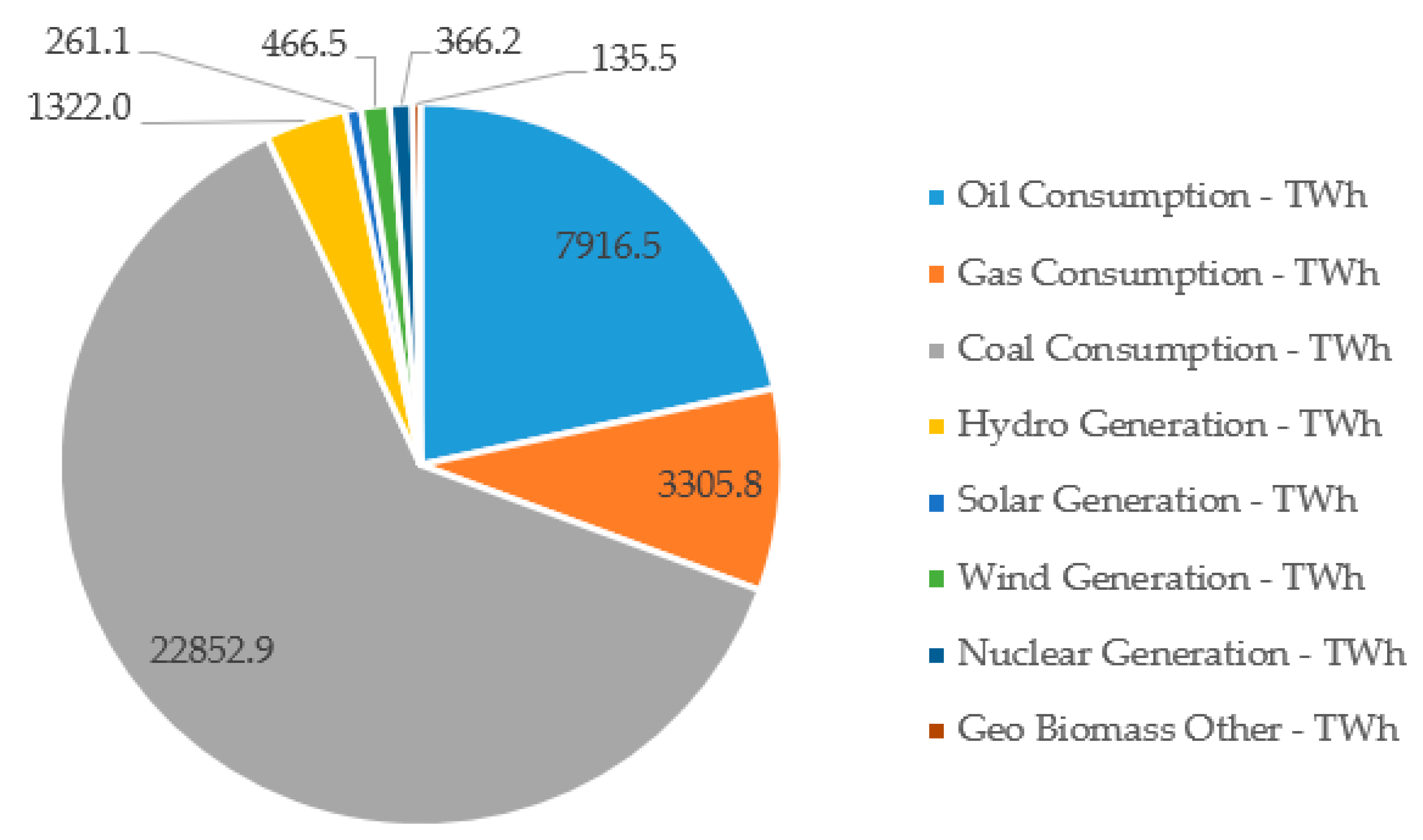
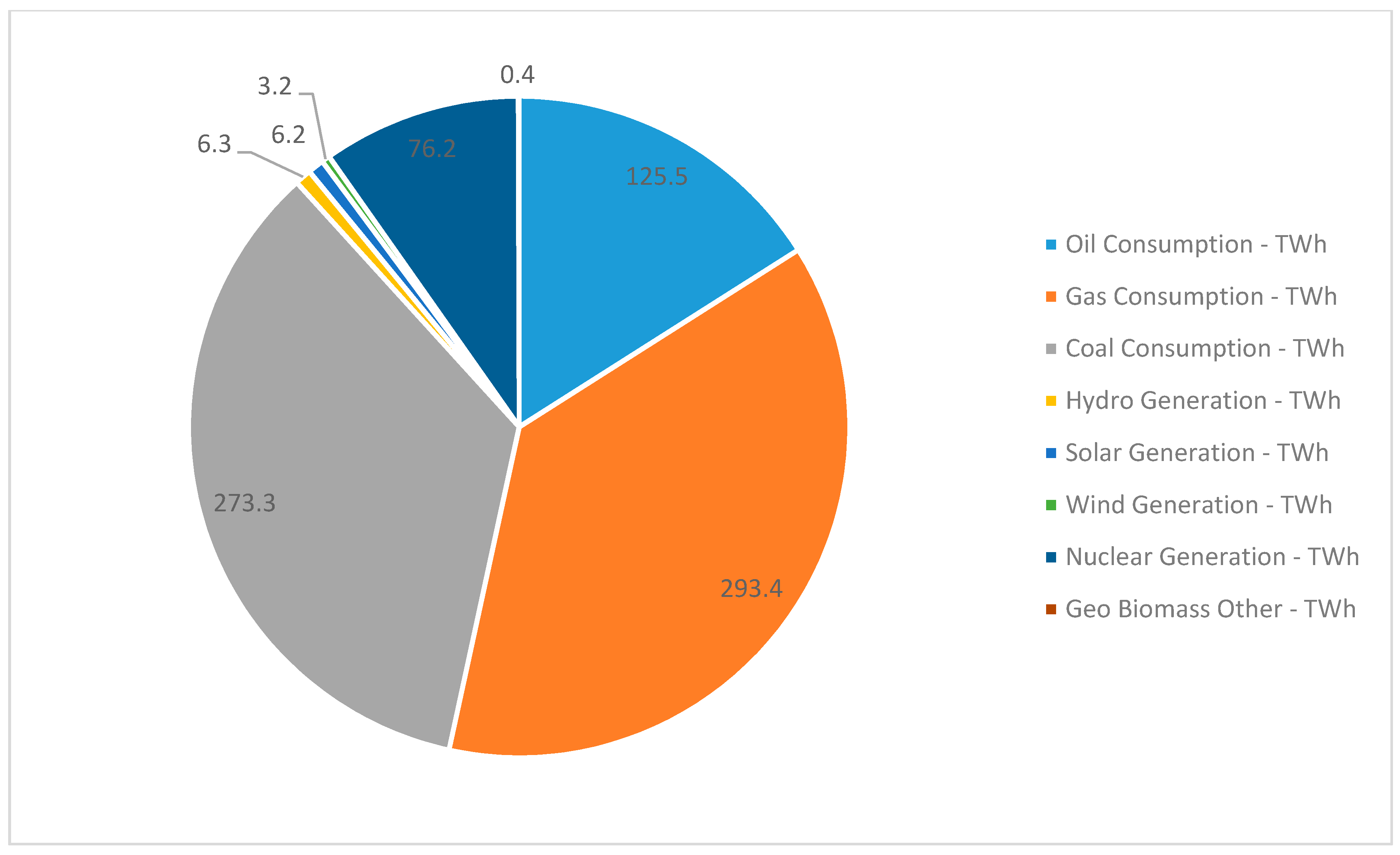
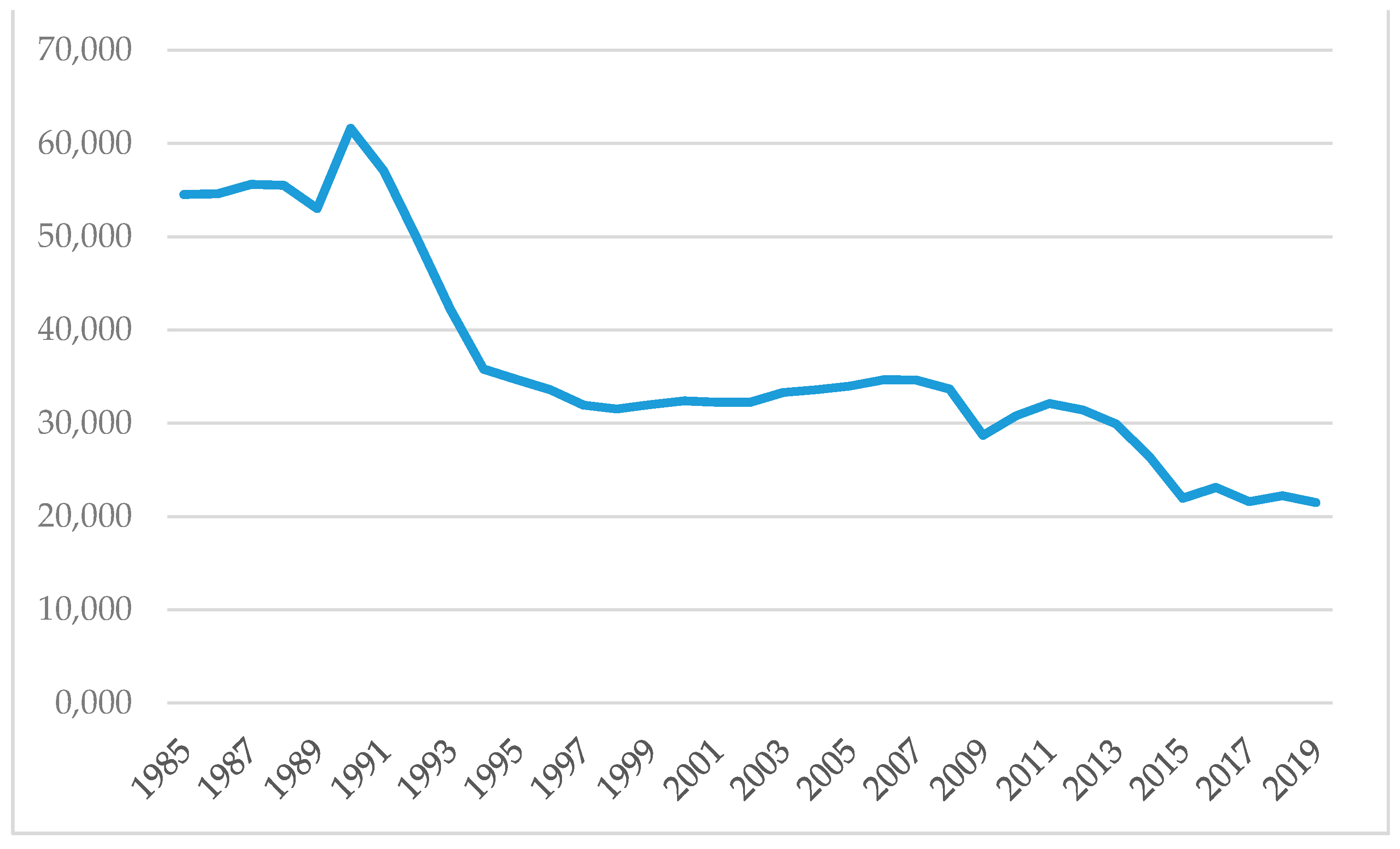
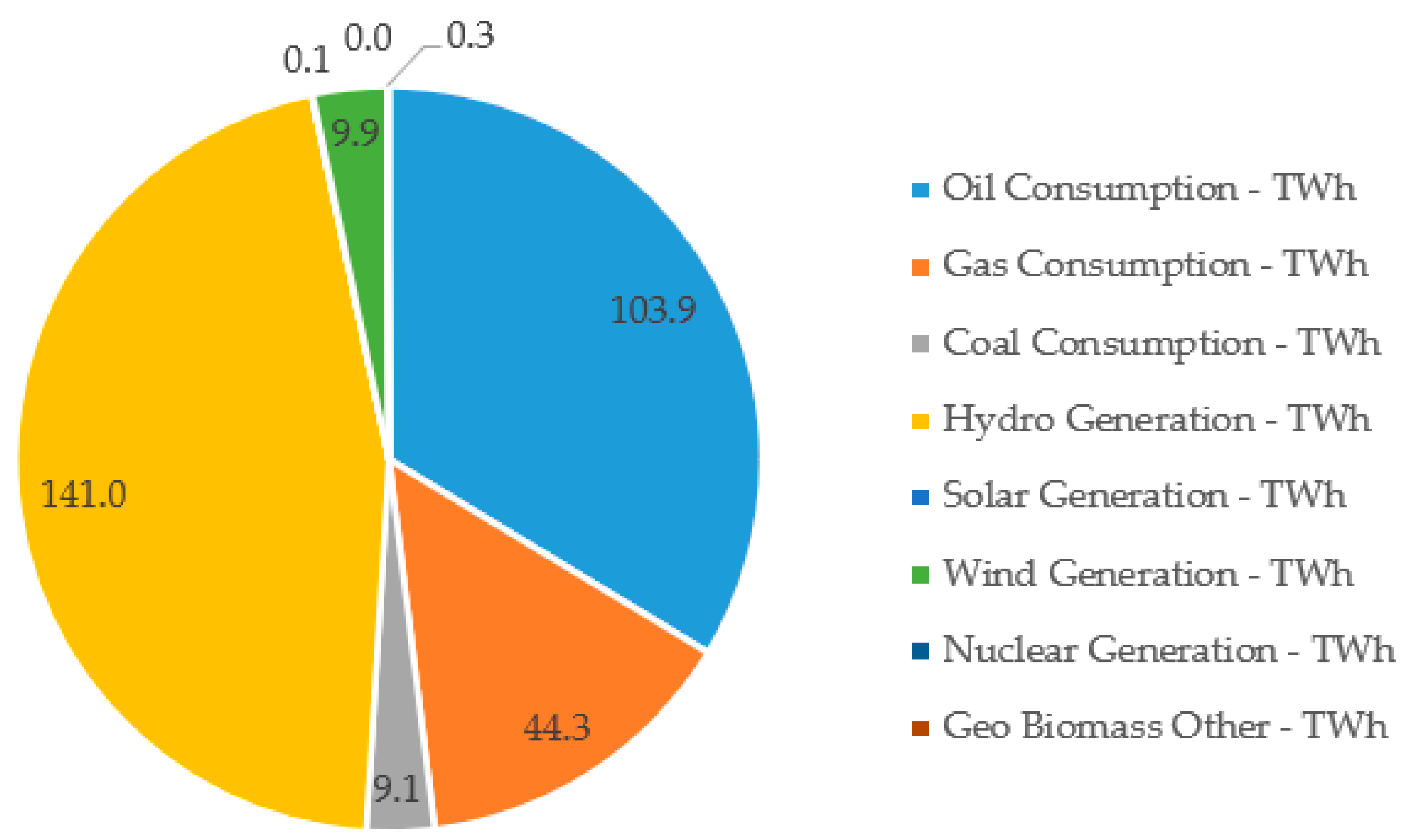

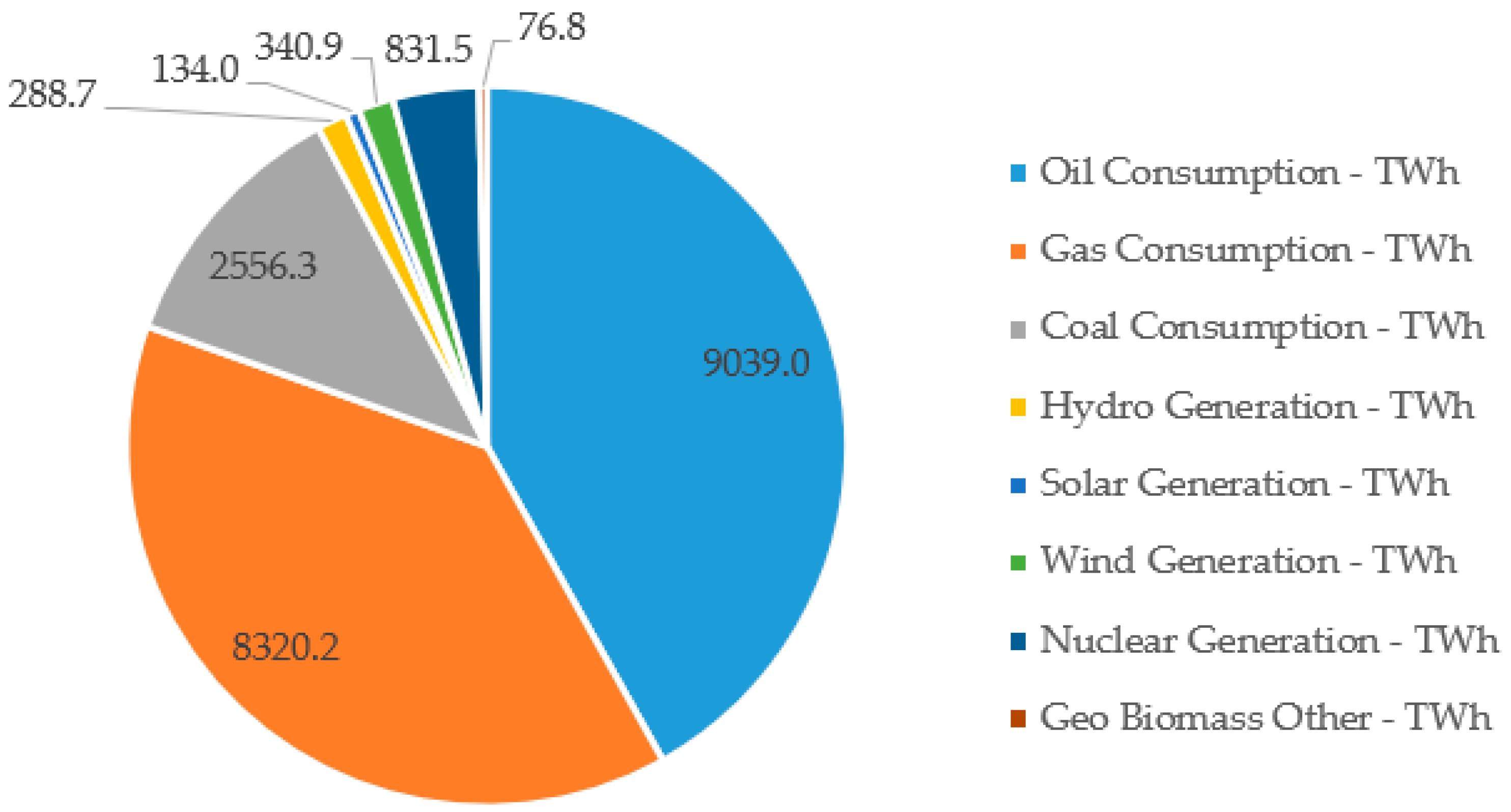
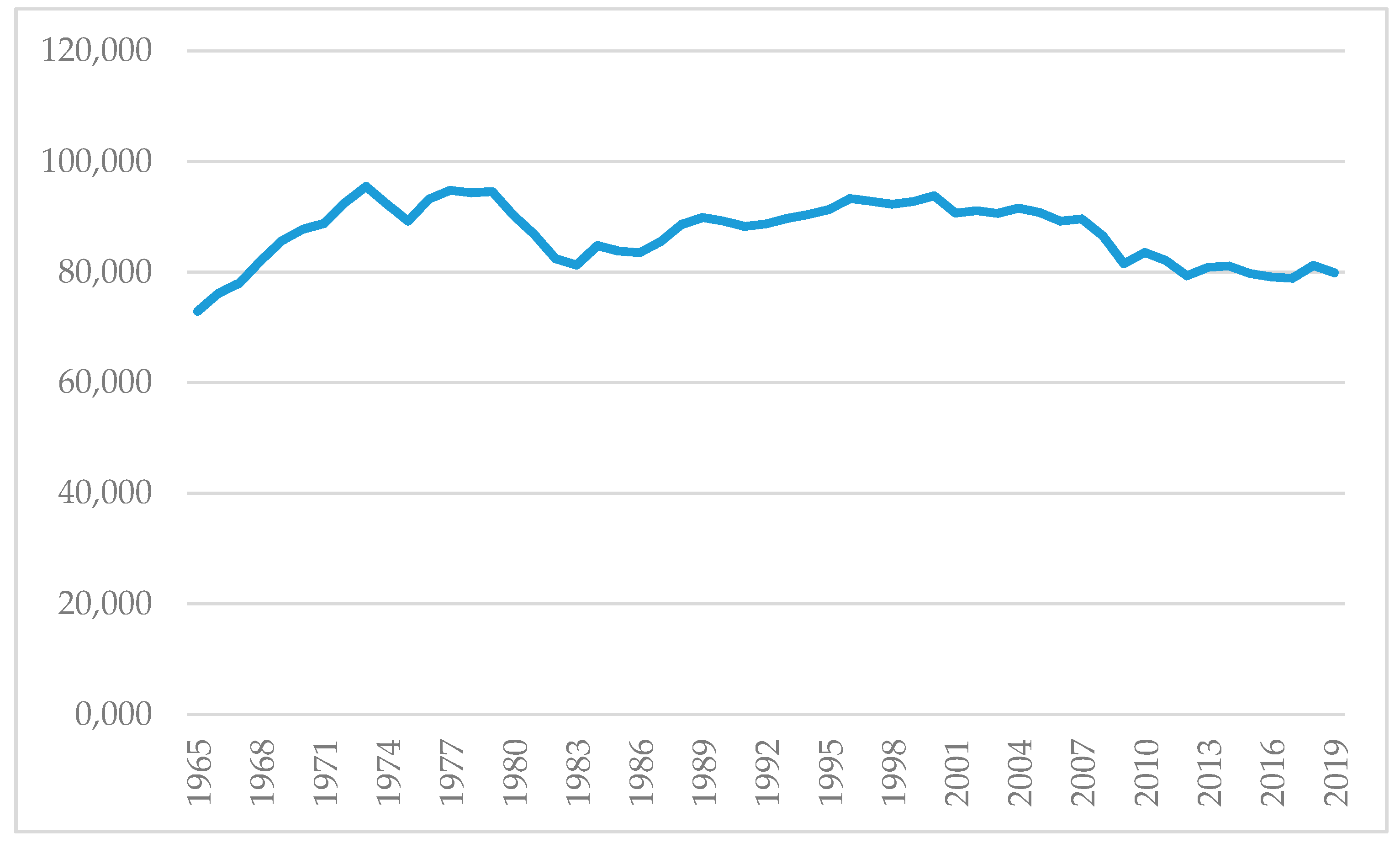
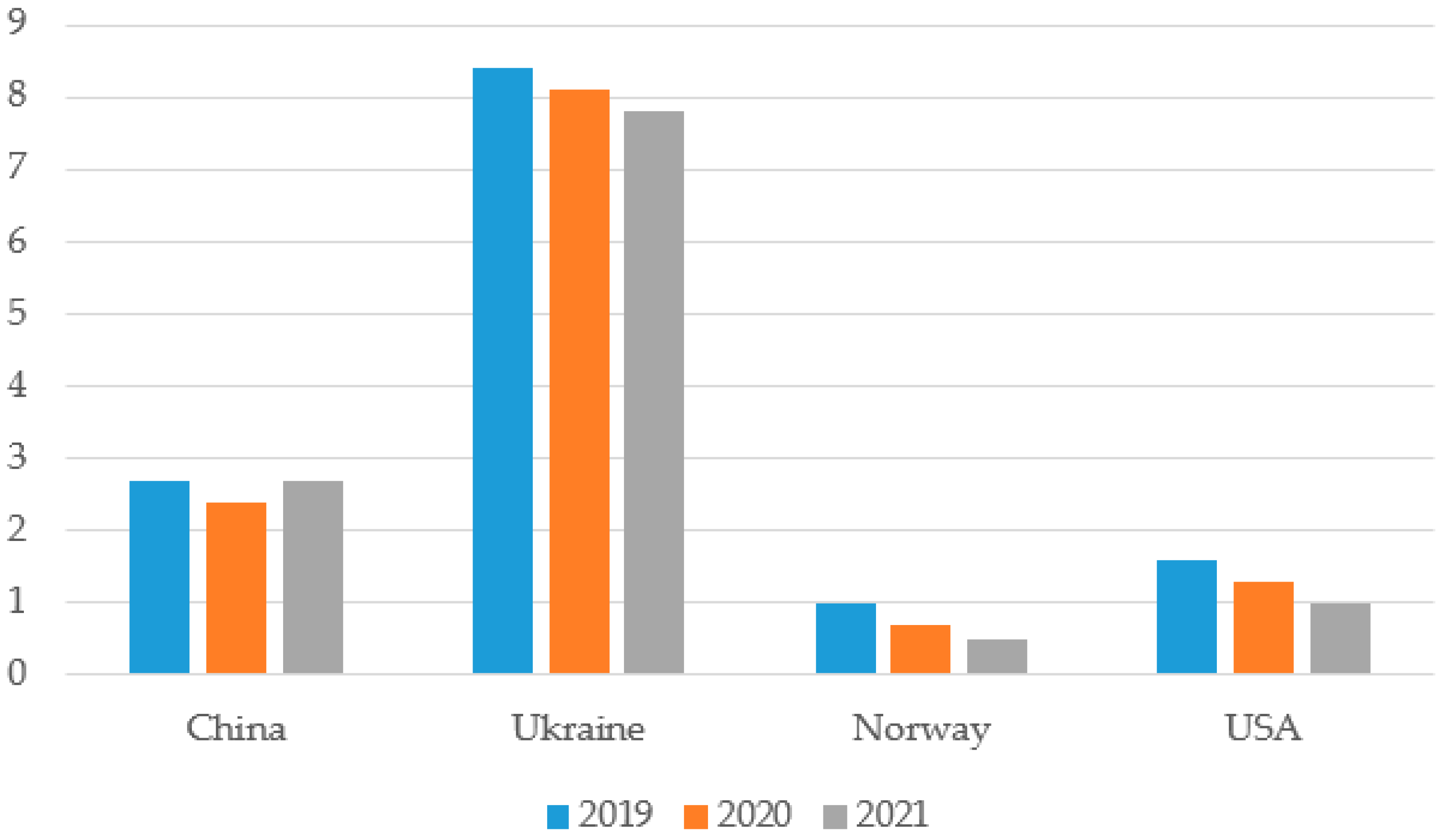
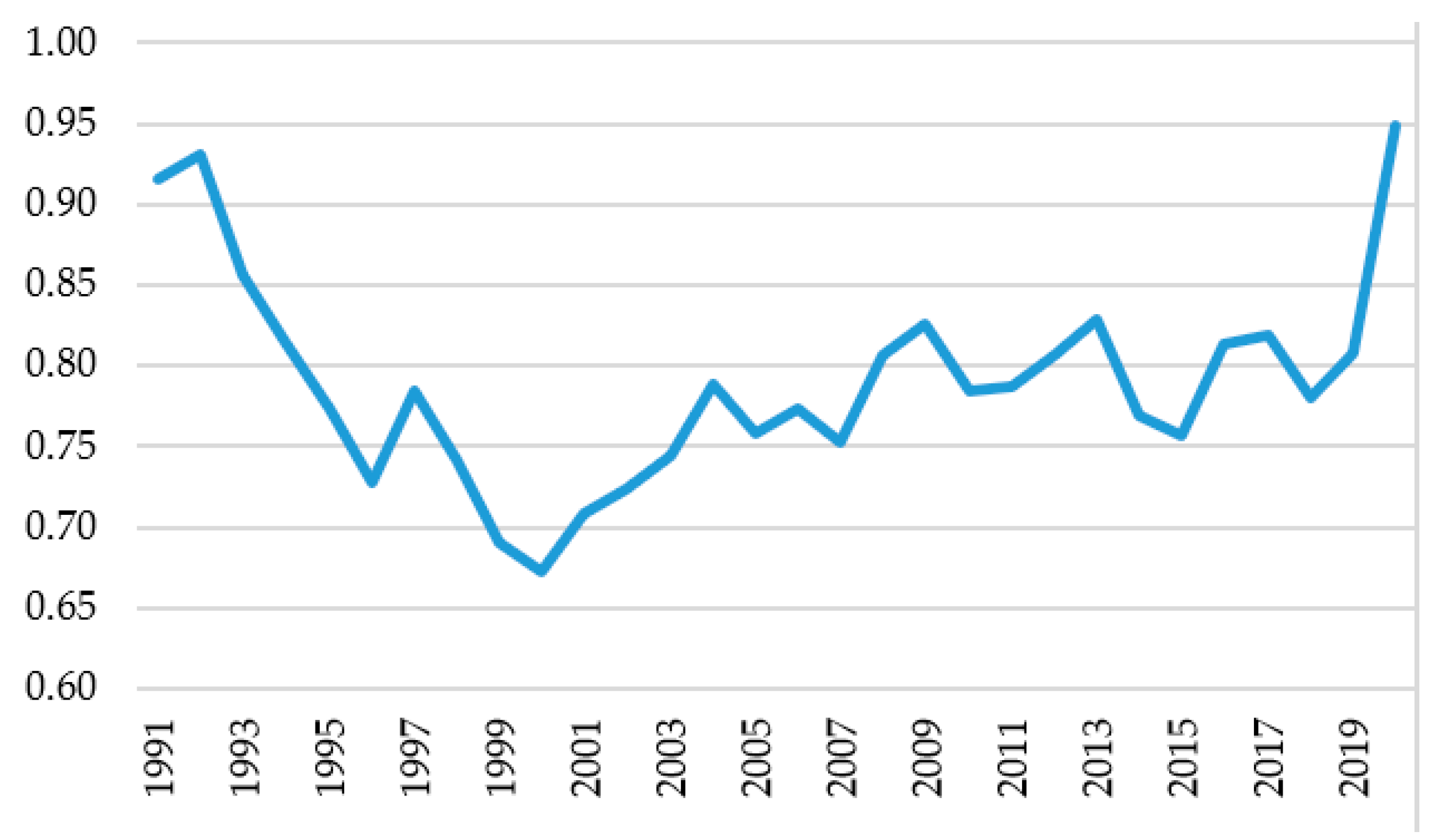
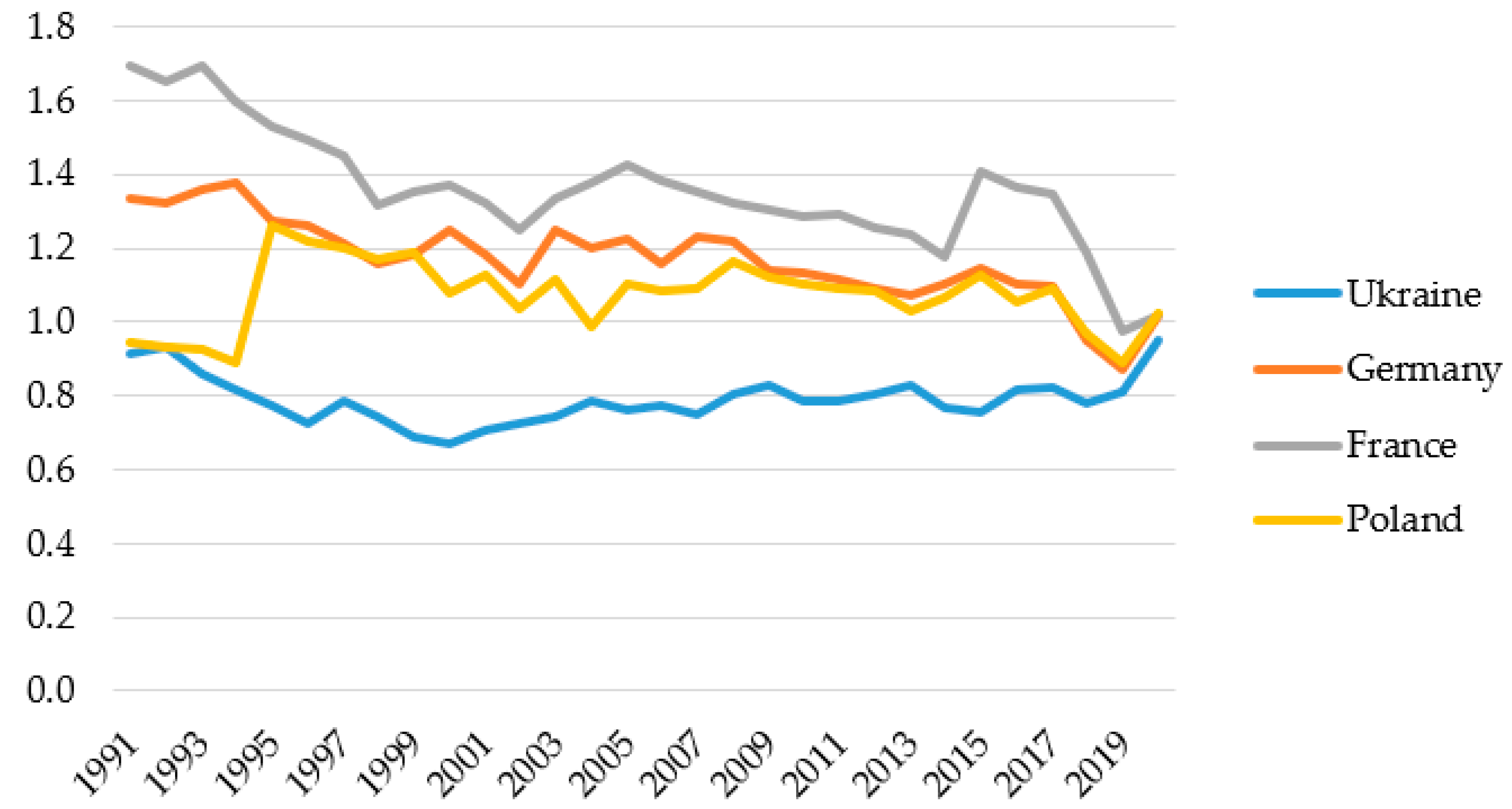
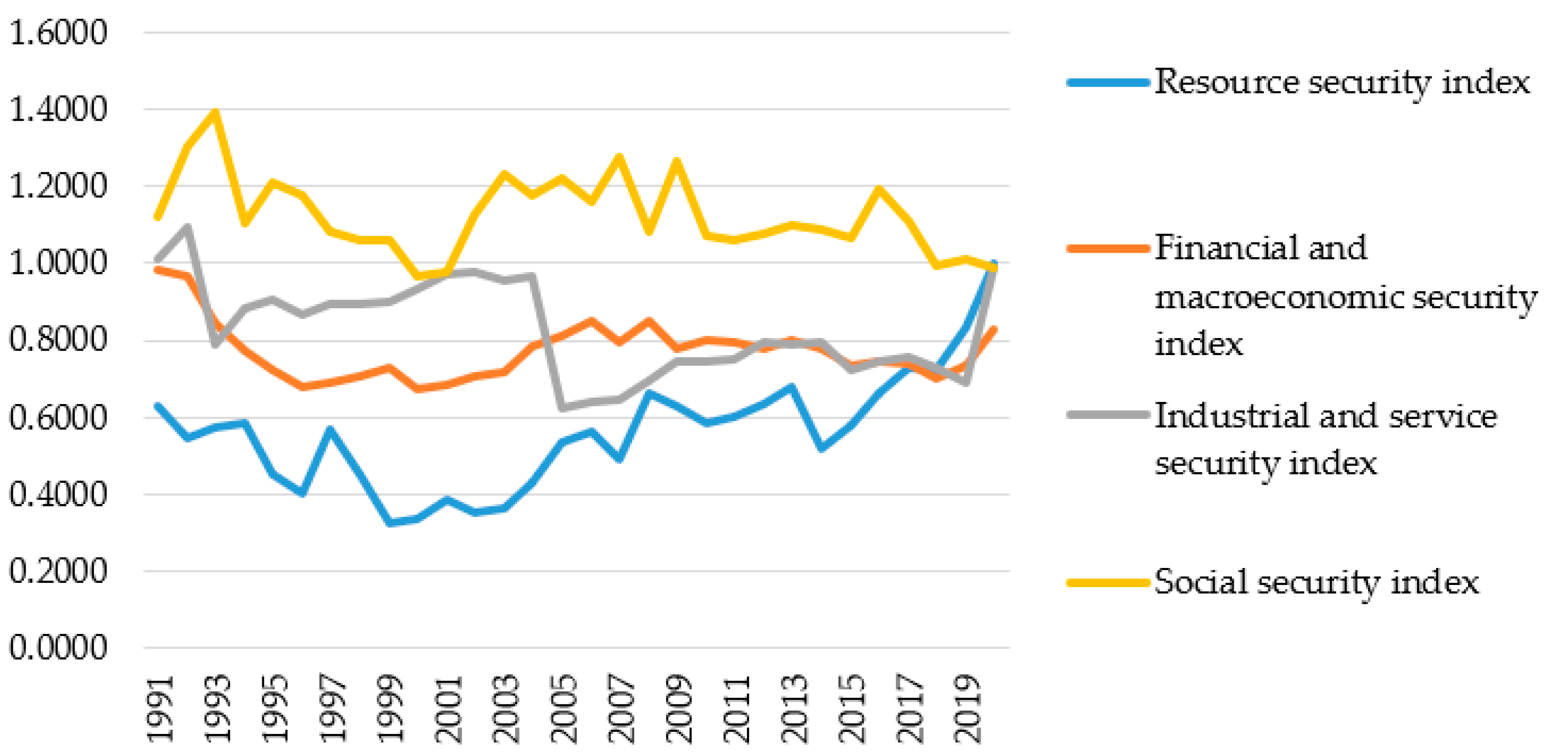
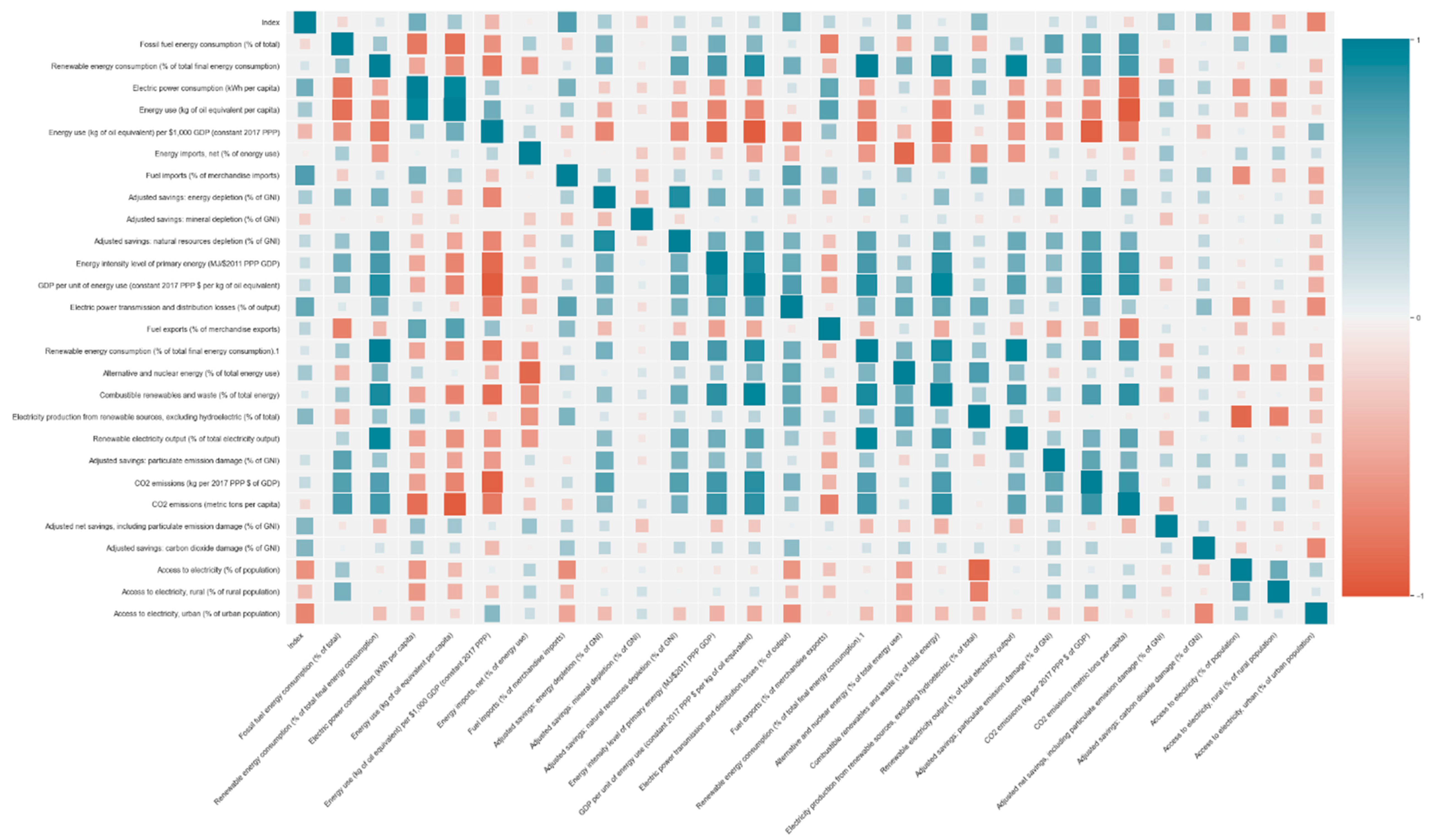

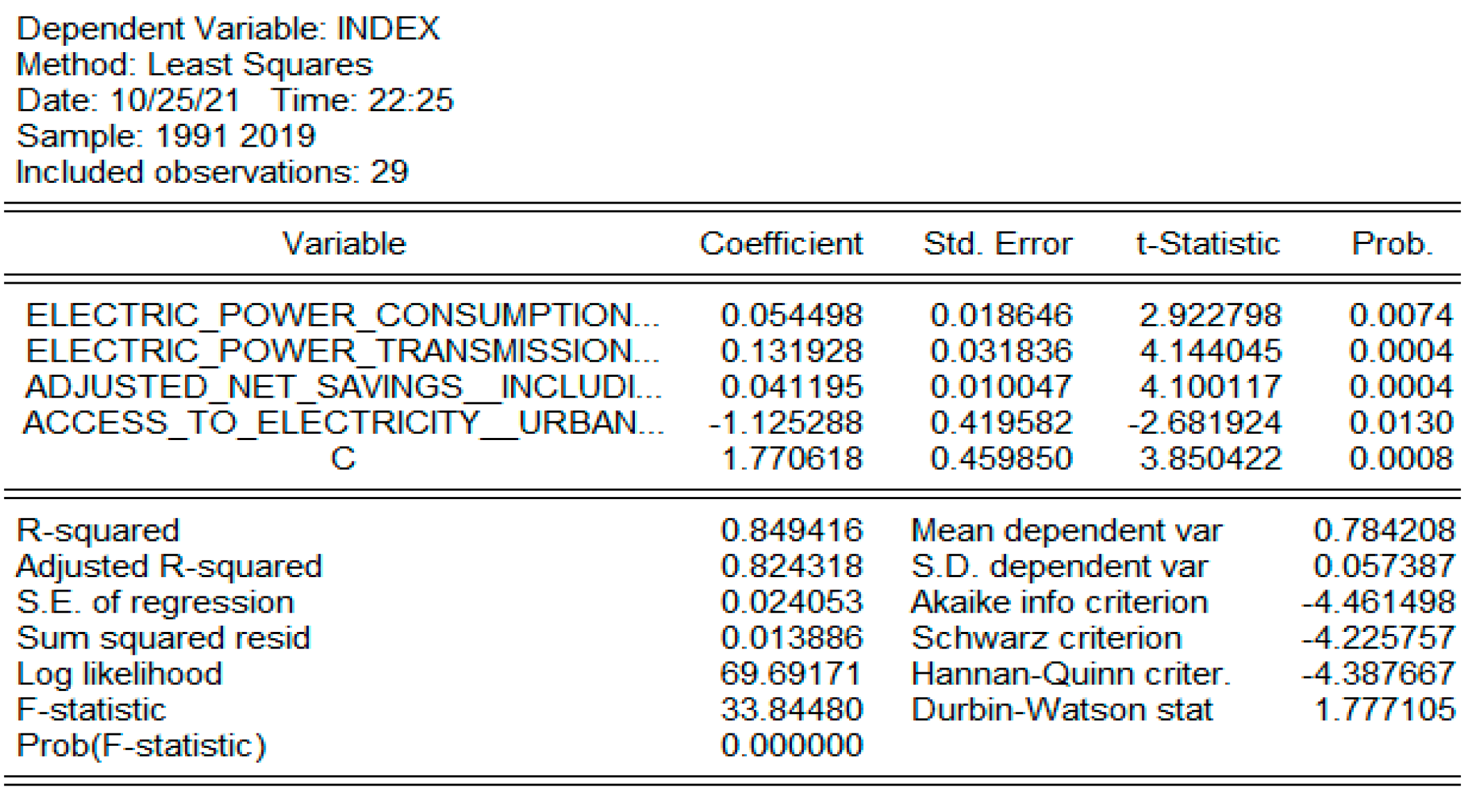
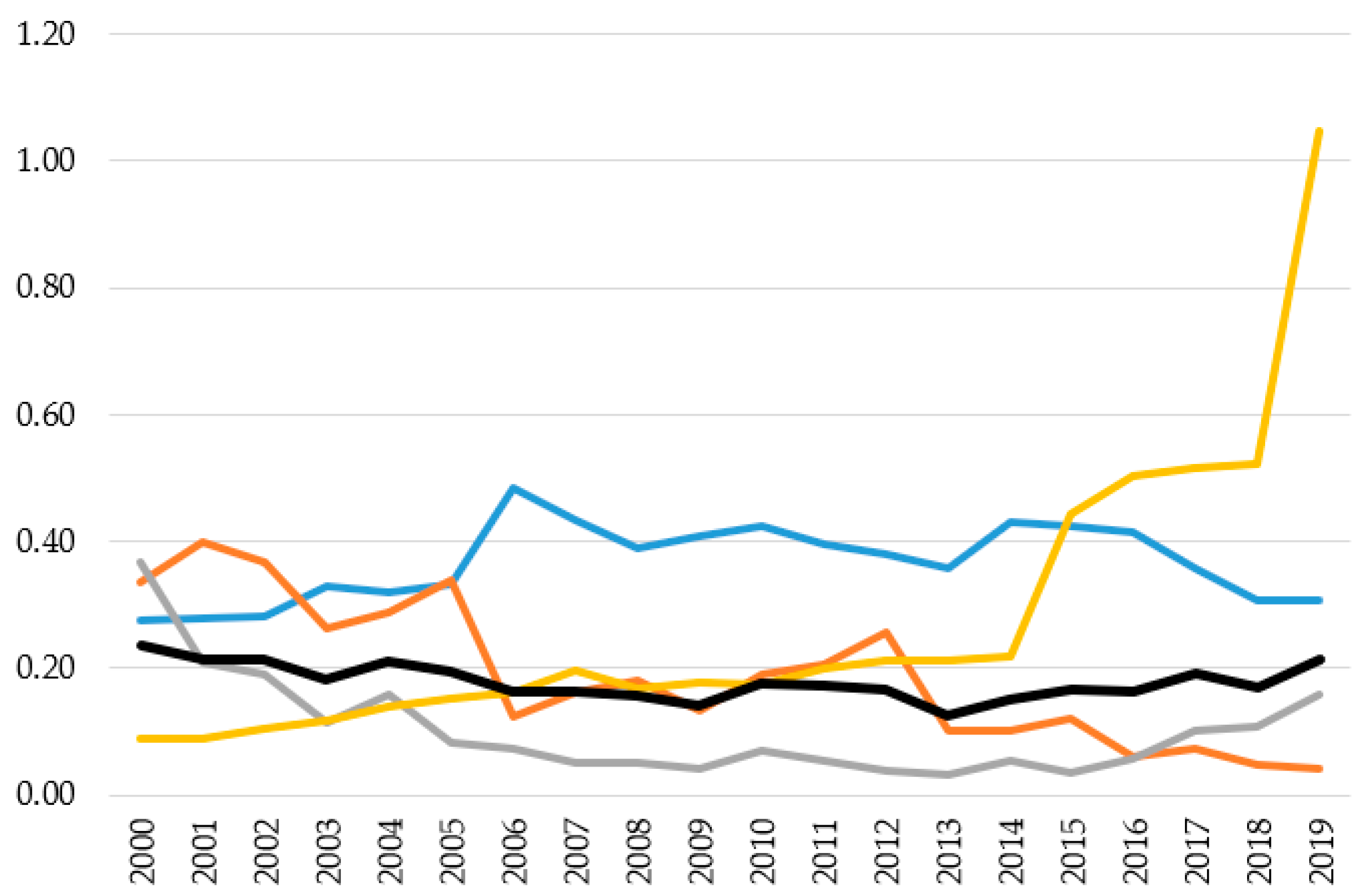
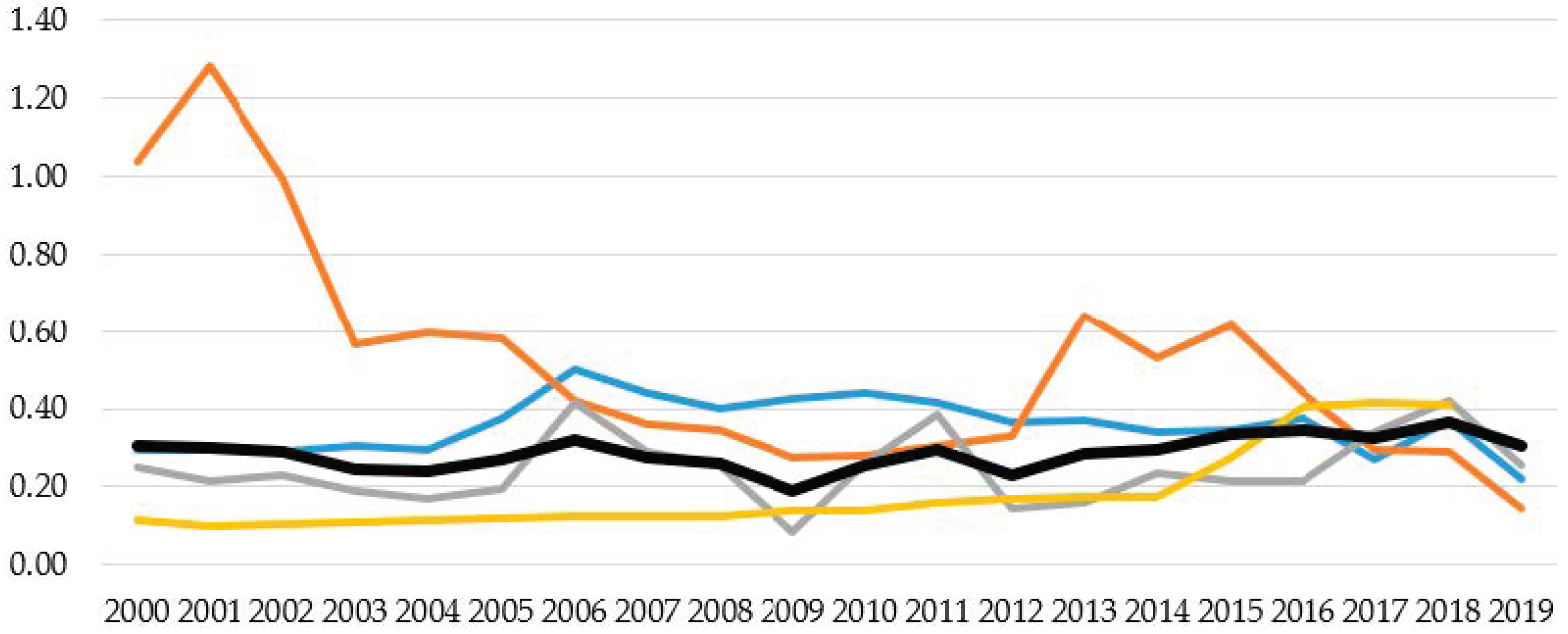
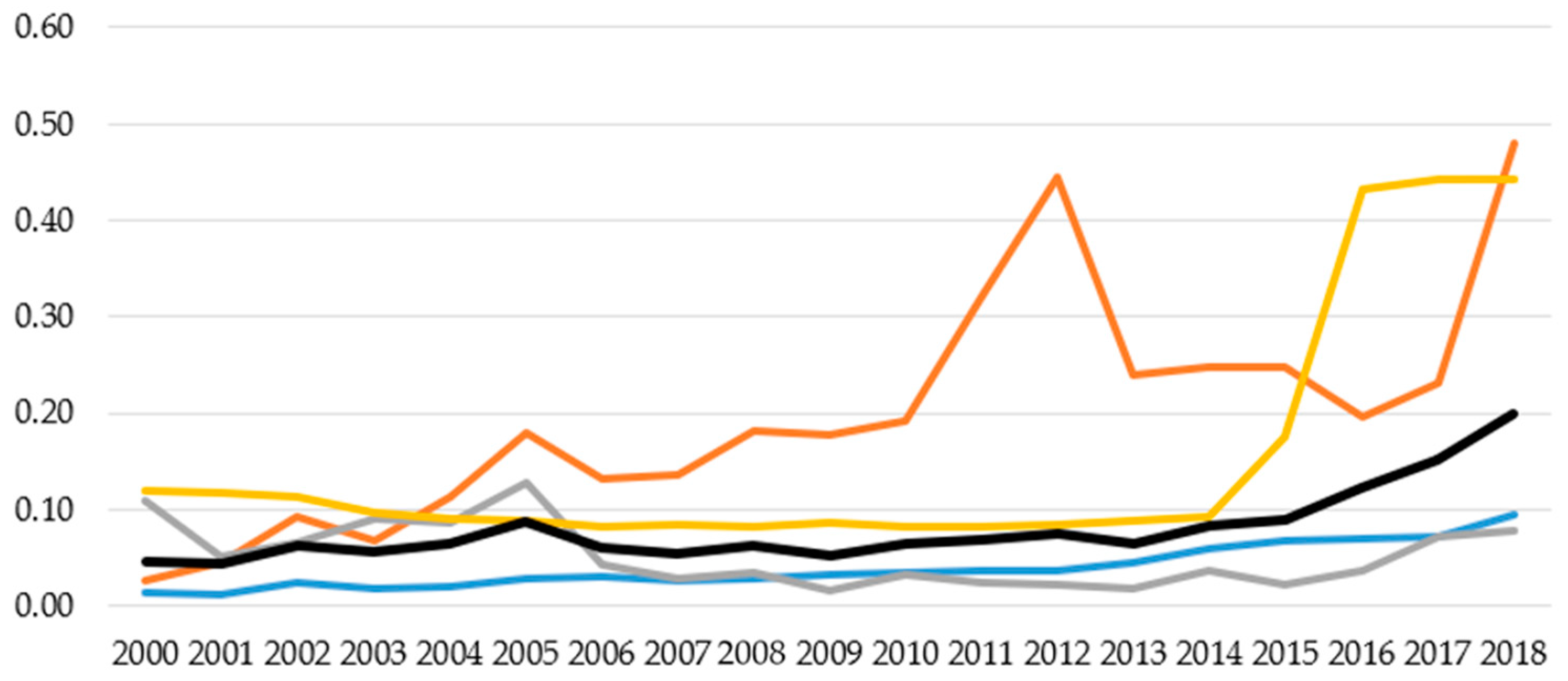
| Title (State) | Short Description | Formula | Energy Security Component |
|---|---|---|---|
| National Security Index (NSI) (India) [46] | The NSI is an average of five other indices: the Human Development Index (HDI), the R&D Index, the Gross Domestic Product Performance Index, the Defense Expenditure Index, and the Population Index. | The Indian National Security Index consists of: 30%—defense capacity 20%—economic power 20%—technology 20%—the effective population 10%—energy security. The index can be calculated as the average of 5 component indices. | The NSI does not cover other aspects of national security, such as the quality of governance, the environment, and the availability of natural resources. |
| Chinese National Power (CNP) (China) | China’s CNP index is the sum of a country’s natural resources, domestic economic capacity, external economic capacity, scientific and technological capacity, level of social development, military capacity, government administrative capacity, and foreign or diplomatic capacity. | This index is calculated using 3 models: where POPU—total population, AREA—the total area of the country, ME—military spending, and ENGY—energy consumption per capita. | Energy consumption per capita is considered. |
| Integral Index of Economic Security of the Country (Ukraine) | One of the main components of national security. The index consists of 9 weighted average sub-indices (components of economic security):
| The calculation of the integrated indicator for each security area is carried out according to the following formula: where is the aggregate indicator/subindex of the m-th sphere of economic security; where m = (1, 2, 3, … 9), di is the weighting factor that determines the degree of contribution of the i-th indicator to the integrated index of the component of economic security; and yi-normalized is the score of the i-th indicator. The integrated indicator of economic security of Ukraine (I) is generally calculated by the following formula: where dm is the weighting factor that determines the degree of contribution of the indicator/sub-index of the m-th sphere of economic security to the integrated index of the economic security of Ukraine; Im—aggregate indicator/subindex of the m-th sphere of economic security, where m = (1, 2, 3 … 9). | The component of the economic security index. There is no official energy security index of national security index. |
| Composed Index of National Capability (USA) | Statistical assessment of the national power of the state, the calculation of which the average percentage of six different world indicators is used. | where TPR = total population ratio, UPR = urban population ratio, ISPR = coefficient of production of cast iron and steel, ECR = primary energy consumption factor, MER = military expenditure ratio, and MPR = army ratio. | The primary energy consumption factor is considered. |
| International Security Index (ISI) | Calculated as the sum of indices of the military, political, terrorist, technogenic, natural, and economic security. | Assessed for the world tensions, the project is finalized in 2020. | Energy security is not directly considered. |
| Security Threats Index [47] | The part of the Fragile State Index calculated by the Global Economy portal. | The security apparatus indicator considers the security threats to a state, such as bombings, attacks and battle-related deaths, rebel movements, mutinies, coups, or terrorism. The security apparatus also takes into account serious criminal factors, such as organized crime and homicides, and perceived trust of citizens in domestic security. The higher the value of the indicator, the more the threats in the state. The average for 2021 based on 173 countries was 5.29 index points. | Energy security is not considered. |
| Title | Description | Components |
|---|---|---|
| International Energy Security Risk Index [48] | Measured risks to energy security in different countries. The index calculates the risk estimates for the United States and 74 other countries that make up the group of largest energy consumers [49]. Scores (index values) for these countries are the ratio to the reference index, which is taken as the average for member countries of the Organization for Economic Cooperation and Development (OECD) in 1980 (adopted per 1000). | Impact of the global fuel market, fuel imports, energy costs, market prices, and volatility, energy use, electricity sector, transport sector, environment. |
| World Energy Trilemma Index [50] | The World Energy Council reflects the assessment of the efficiency of the country’s energy system. Balancing these three goals is a “trilemma” and ensures the prosperity and competitiveness of individual countries. The report presents a comparative ranking of 128 countries. The evaluation of the index is that the effectiveness of individual countries in developing and implementing policies to ensure energy sustainability varies from country to country and region to region. The World Energy Council recognizes the value of adopting an integrated approach to energy systems to benefit sustainable energy for all. | The 3 main dimensions: energy security, energy justice, and environmental sustainability. Efficiency indicators include supply and demand, energy availability and accessibility, energy intensity and efficiency, and emissions related to energy systems. Contextual indicators take into account the broader context of energy efficiency, including the country’s ability to provide coherent, predictable, and stable policies and regulations, initiate R&D and innovation, and attract investment. |
| Energy Transparency Index [51] | Developed to assess the real state of availability and quality of the information in the energy sector and to diagnose gaps. The index covers 210 indicators, grouped into 8 categories and based on specific regulatory requirements and best global disclosure practices. The evaluation is the result of processing open-source data on the functioning and development of the energy sector along the chain “from producer to consumer”. | Balances natural monopolies, supply, reliability and security, consumption, reporting, policy, and government. |
| ESRI | ESI | STI | |
|---|---|---|---|
| ESRI | |||
| ESI | Ch (r = −0.51), USA (r = −0.70) | ||
| STI | UKR (r = 0.99) Ge (r = 0.69) USA (r = −0.91) | U.S.A. (r = 0.80) |
| Indicator | Germany | USA | China |
|---|---|---|---|
| Adjusted savings: damage to carbon dioxide (% of GNI) | + | ||
| Adjusted savings: depletion of minerals (% of GNI) | + | ||
| Energy consumption from fossil fuels (% of total volume) | + | ||
| Production of electricity from renewable sources, except hydroelectric power plants (% of total) | + | ||
| Fuel imports (% of goods imports) | + | ||
| Adjusted net savings, including loss from greenhouse gas emissions (% of GNI) | + | + | |
| CO2 emissions (kg per capita in 2011 in GDP) | + | + | |
| Adjusted savings: energy depletion (% of GNI) | + | ||
| Electricity consumption (kWh per capita) | + | ||
| Renewable electricity production (% of total electricity output) | + | ||
| Electricity transmission and distribution losses (% of output) | + | ||
| Generation of energy from renewable sources and waste (% of total energy) | + |
Publisher’s Note: MDPI stays neutral with regard to jurisdictional claims in published maps and institutional affiliations. |
© 2022 by the authors. Licensee MDPI, Basel, Switzerland. This article is an open access article distributed under the terms and conditions of the Creative Commons Attribution (CC BY) license (https://creativecommons.org/licenses/by/4.0/).
Share and Cite
Mara, D.; Nate, S.; Stavytskyy, A.; Kharlamova, G. The Place of Energy Security in the National Security Framework: An Assessment Approach. Energies 2022, 15, 658. https://doi.org/10.3390/en15020658
Mara D, Nate S, Stavytskyy A, Kharlamova G. The Place of Energy Security in the National Security Framework: An Assessment Approach. Energies. 2022; 15(2):658. https://doi.org/10.3390/en15020658
Chicago/Turabian StyleMara, Daniel, Silviu Nate, Andriy Stavytskyy, and Ganna Kharlamova. 2022. "The Place of Energy Security in the National Security Framework: An Assessment Approach" Energies 15, no. 2: 658. https://doi.org/10.3390/en15020658
APA StyleMara, D., Nate, S., Stavytskyy, A., & Kharlamova, G. (2022). The Place of Energy Security in the National Security Framework: An Assessment Approach. Energies, 15(2), 658. https://doi.org/10.3390/en15020658








